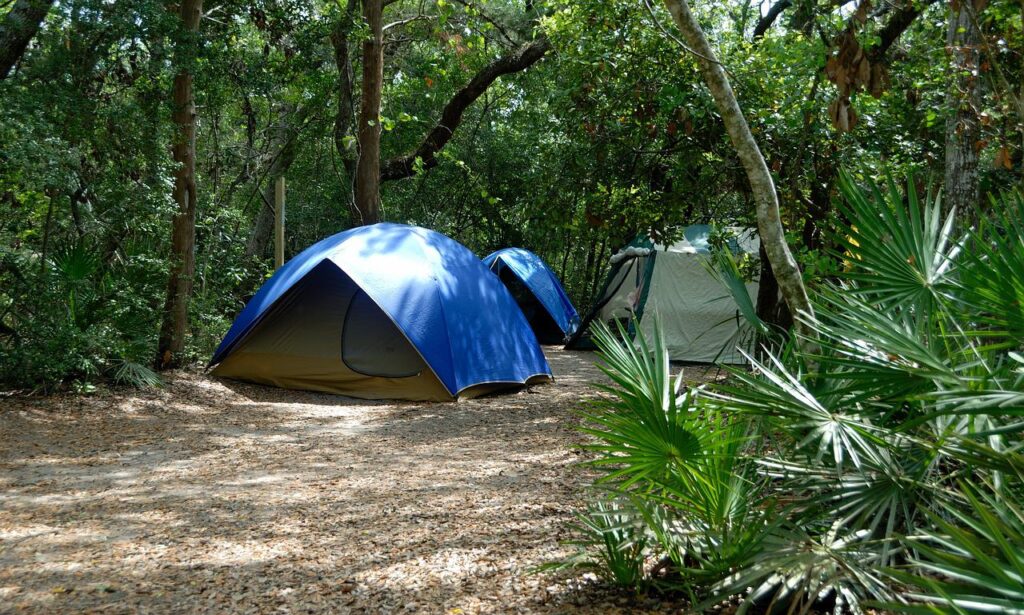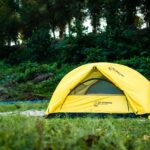The best tent rainfly can make all the difference on your next camping trip! A rainfly or flysheet (also known as rain cover) can be used to block out rain and keep you dry during your time in the great outdoors, but it also serves another purposes. If you are looking to purchase the best tent rainfly, but aren’t sure which one to go with, here are some things to look for and consider
Table of Contents
What is a rainfly used for?
A rainfly, also called a flysheet, is a waterproof cover for a tent. It protects against precipitation and keeps the inside of the tent dry, and at the same time the extra layer will provide more protection from the sun and its UV effects.
When camping under trees it will help protect your tent from falling tree debris or animal droppings. If you are camping in a sandy or dusty environment the rainfly can help protect your tent and prevent any sand from entering. A good rainfly will also provide ventilation to prevent condensation from building up inside the tent.
When choosing a rainfly, be sure to select one that is made from waterproof and breathable fabric. You’ll also want to make sure it’s the right size for your tent and that it has enough guy lines to keep it secure in windy conditions.
Types of rainflies/flysheets
There are different types of rainflies depending on the material they’re made from and how much coverage they provide. Some common materials used for rainflies are nylon, polyester, and canvas. When choosing a rainfly, it’s important to consider how much coverage you need and what kind of weather you’ll be using it in. For example, if you plan on staying dry while going through heavy storms, choose one with a durable water-resistant coating. If you want something lightweight and waterproof but not as protective as some other options, then there are plenty of choices out there too.
Rainflies will either be partial or full coverage, and both have their pros and cons.
For example, a full coverage rainfly which will completely cover the tent, will provide better protection from rain and winds, but will be heavier and restrict good airflow around the tent which could lead to a hot and humid tent. Partial coverage rainflies are better suited for mild and warm climates as they will provide better air circulation around the tent at the same time partially protecting you from rain and direct sunlight.
How to pitch a rainfly/flysheet
A flysheet is a waterproof cover for my tent that helps protect against bad weather. It’s important to know how to pitch a rainfly correctly so that it doesn’t blow away in the wind. Some rainflies come pre-attached to the tent, but mostly they are a separate and optional piece of gear.
Here’s a step-by-step guide:
- Choose a spot for your tent that’s level and clear of debris.
- Lay out the flysheet over top of your tent. If the rainfly has any zips (for doors) make sure they are zipped before you start staking or strapping down your rainfly.
- Connect your flysheet to each corner of the tent
- Pitch your tent and stake it down before you start staking or strapping down your flysheet.
- Start at one end and stake/strap down the corners of the flysheet.
- Pull the flysheet taut and stake/strap down the other corners.
Some rainflies come with Velcro straps, use the straps to attach the rainfly to the poles of the tent. Make sure your flysheet is nice and taut as its main purpose is to prevent your tent from rain, you want the rainwater to run down the flysheet and not collect in any loose fabric.
How do I choose a rainfly / flysheet for my tent?
How do I choose a rainfly / flysheet for my tent?
A good quality rainfly or fly sheet will provide a waterproof cover for your tent and keep you dry even in the heaviest downpour. It’s important to choose one that is durable and well-made, as well as the right size to fit your tent. You also need to make sure it has proper ventilation to prevent condensation build-up inside the tent. With so many factors to consider, it can be tough to choose the best rain fly for your needs.
Most modern tents have rainflies that were designed specifically for the tent you have purchased, so look at their options and you will be comfortable knowing that it’s going to fit the tent perfectly. But if there is no rainfly available for your tents specific model then following these simple guide lines will help you find the perfect one for your next camping trip! Features you should look for, when choosing a rainfly:
- The ability to withstand high winds
- Adequate air flow for moisture management
- Ability to stay taut against your tent
- Easy attachment process.
- Portable and easy to store – doesn’t take up much space when not in use.
- Correct size – to cover the whole tent
How to care for rainflies/flysheets
To care for your rainfly, keep it clean and dry when not in use. If it gets wet, hang it up to dry as soon as possible. Store it in a cool, dry place when not in use. Waterproof materials are less likely to develop mold or mildew if stored properly. You want to store your rainfly away from heat sources like fireplaces, wood stoves, and hot water pipes. Keep away from direct sunlight too.
Recommended tents with rainfly included
Brand | AGLORY | CAMPROS CP | CAMEL CROWN | PACIFIC PASS | COLEMAN | HYKE & BYKE |
Rainfly | Yes | Yes | Yes | Yes | Yes | Yes |
Occupancy | 2 / 4 | 6 | 2 | 2 / 4 / 6 | 8 | 1 / 2 |
Material | Polyester | Polyester | Polyester | Polyester | Polyethylene | Polyester |
Related Guides and Articles
-
How to choose the right size tent for your next camping trip
Choosing the right size tent to use while camping can be daunting, especially if you’re…
-
Tent Footprints and Groundsheets for Camping
A tent footprint or groundsheet is a protective sheet of fabric or material that is…
-
10 Ideas to Keep Kids Busy on Your Next Camping Trip
If you’re going on a camping trip and you want to be able to enjoy…











